Sacred Geometry and Architecture
Geometry and Sacred Architecture are closely related to the issue of Dolmens and Menhirs, discussed in another our article. We will undertake a small research related to Santa Maria del Mar church in Barcelona, besides the urban issue that is of vital importance from the time before the Romans, when it is believed that the Phoenicians reached the coast, and when Laietan tribe lived near Mount Taber or Montjuic. We will discuss some topics such as: pre-Roman and Roman temples, the foundation of the city by Emperor Augustus (based on the texts of Vitruvius), the Vesica Pisces, the Fortifications (Vaubun, pentagons, Citadel - Ciutadella), the “widening” (Eixample) of Ildefons Cerda, the Universal Exhibition of 1888, the International Exhibition of 1929, and urban changes due to the celebration of the 1992 Olympic Games.
Want to know more? book our tour Barcelona's Old Town.
We started this small research to the subject with Santa Maria del Mar church:
Santa Maria del Mar church and the tradition of Santa Eulalia

A book of 1878 tells that Santa Maria del Mar church is one of the oldest temples in the city, where, according to the tradition, the remains of Saint Eulalia, the former patron of Barcelona until 1687 (because now the patron saint is the Virgin of Mercy, and is co-patron with Saint Matrona) and possibly the Principality of Catalonia, were found. A chronicler of the sixteenth century attributed its foundation to the Goths (we know that the Basilica of Santa Maria del Mar was built by the architect Berenguer de Montagut and his assistant Ramon Despuig, and was the temple of ship-owners and merchants of the gothic Barcelona). In ‘La Ilustración española y americana', Year XXII, no. 15. 22 April 1878, was narrated that the primitive Basilica was called Santa Maria de Las Arenas (Santa Maria de Les Arenes), the same author notes that it was named for being situated in the same sea, and was built on the remains of a previous early Christian temple dedicated to Minerva (Menrva [Etruscans] = Minerva [Roman] = Athena [Greek]), although very recent studies such as the 'Grup de Recerques in Antiguitat Tardana' of the University of Barcelona, tell us that the location of the church is the same where the amphitheater of Barcelona was situated in Roman times, hence the real name “of the sands”, and the reason was its direct proximity to the sea in ancient times; but the mystery continues.

Images: Minerva - Menrva - Athena
According to recent history, known by many, its construction began in 1329 and ended in 1377. The building consists of 3 large naves separated by large octagonal pillars that support 19 arches and high vaults, and around them there are 33 chapels devoted to worship, and it is all of Catalan gothic style.
The number of consecrated chapels - 33 (highest degree in Freemasonry of the Scottish Rite, and this is generally known as the age of Jesus Christ dying on the Cross) draws attention, and a reference of an ancient Roman temple dedicated to Minerva was made in that work; although it was probably not dedicated to her, but rather to roman goddess Venus, also known as Ishtar in Mesopotamia, Astarte of the Phoenicians, or rather are those reminiscent of the Ancient Egyptian goddess Isis. We'll see how there is a subtle common thread links worship of Venus with the famous legend of the old patron saint of Barcelona and sailors, Santa Eulalia.

Image: Santa Eulalia (1879) - Barcelona City History Museum

Image: Astarté - Ishtar - Venus
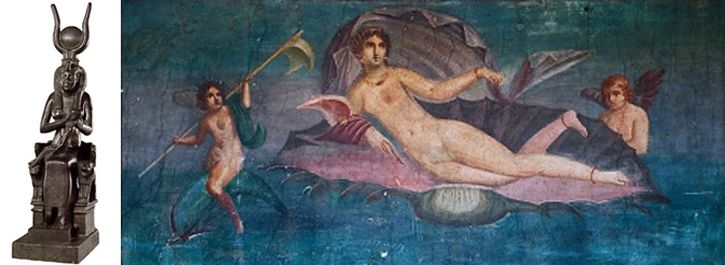
Images: Isis (Ancient Egypt), Venus born from the sea (fresco from Pompey)
In prehistoric art, since the Venus of Willendorf was discovered in 1908, they called the small female sculptures of rounded shapes 'Venus Paleolithic’. Although the name of the deity actually represented is unknown, the obvious contrast between these cult figures, obese and fertile, and the classical conception of Venus has demonstrated a great resistance to the terminology. Venus became a popular subject in painting and sculpture of the European Renaissance. As a classical figure whose natural state was the nakedness, it was socially acceptable to represent it without clothes. As the goddess of sexual health, a degree of erotic beauty in her portraits was justified. On the other hand the legend of the medieval Germany Tannhäuser is an interesting vestige of the myth of Venus that survived much after its cult was banished by Christianity (a representation of this legend can be observed in a painting by John Collier, 1901, called 'Tannhäuser in the Venusberg', which depicts goddess Venus, along with another painting by John William Waterhouse, 1885, which depicts a character very similar to Saint Eulalia).

Image: Venus of Willendorf

Image: Painting of John Collier (1901), 'Tannhäuser in the Venusberg' (Atkinson Art Gallery, Southport, Lancashire, UK)

Image: Painting by John William Waterhouse (1885), 'Saint Eulalia' (England, London, Tate Gallery)
We remember that Venus is also associated with other myths, like the myth of Eurynome, with the mother of all things, arising from the initial chaos, or the goddess Cibeles in Asia Minor, or Aphrodite in Greece, which emerged from the waves so naked and beautiful as she is usually represented, so the sea becomes the cradle of the goddess and hence in its main sanctuary in Paphos (current Cyprus), priestesses bathed ritually in a nearby sea as a remembrance of his birth.

Image: Mith of Eurynome - Greek glass (Boston Museum, United States)

Photo: Cybele (Getty Villa Museum, Pacific Palisades, California, United States)

Photo: Aphrodite - Ludovisi Throne's relief (Altemps Palace, Rome, Italy) (Source: Nguyen Marie-Lan)
, dibujo de Antoniadi, 1939.jpg)
Image: Aphrodite´s Sanctuary of Paphos (Cyprus) (Caracalla's coin (198-217), Antoniadi's drawing (1939))
Let us add an intrinsic data of Aphrodite, that she is the one who breaks soon to fly through the skies accompanied by sparrows and pigeons, which are, among others, their symbolic animals (such as geese that we can see in remembrance to Santa Eulalia in the Cathedral of Barcelona). Let us also remember the myth of goddess Cibeles, about the fifth century B.C., which tells us about the oracle of the Sibyls, who spoke through the voices of birds in the sanctuary, and the history of Santa Eulalia, for what it is known, that she was a woman who lived between the III - IV centuries A.D., and was a virgin that at the age of 13 years died martyred on a bent cross. According to the tradition people saw a white dove flying through the air when she was dying, so that Santa Eulalia also became a patron saint of birds, and as in the myth of Cibeles, currently associated with geese, pigeons and pheasants that can be seen in the cathedral of Barcelona (as well as in the city of Lugo, Spain). And speaking of the possible connection of Aphrodite with Santa Eulalia, on one of the portals of the Church we can see a carved figure of the Virgin Mary behind a seashell, a characteristic image of the same Greek Aphrodite or the roman goddess Venus.

Image: Sibyl - Painting of John Collier (1891) - 'Priestess of Delphi' (Art Gallery South Australia)

Image: Martyrdom of Santa Eulalia (1452) (Vic Episcopal Museum)
.jpg)
Photo: Santa Eulalia church in Lugo (Lugo, Spain) (Source: www.xunta.gal)
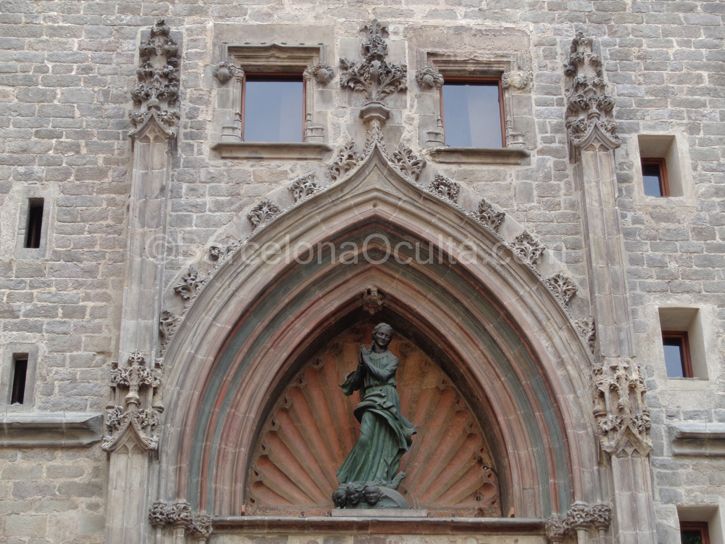
Photo: Virgin Mary with seashell over the entrance of Santa Maria del Mar church in Passeig del Born (Barcelona, España)
Let`s also mention briefly the lover of goddess Cibeles in Greek mythology, the deity-man Atis or Attis, who went mad about the goddess Cibeles and castrated himself (remembering that the myth of OSIRIS of Egyptian mythology). This demi-god originated from Phrygia, current Anatolia in Turkey. In art he is represented with a Phrygian cap, and here it should be noted that the Phrygian cap has been for a long time one of the symbols of the Masonic brotherhoods, and that formerly represented god Mithra in Iranian mythology; in Roman times was called pileus, and was distinctive of freedmen, was symbolically used by the murderers of Julius Caesar, and during the US Independence and the French Revolution, was used as a symbol of Liberty. Today it appears in several coats of American nations, in an ancient mosaic the Three Wise Men can be seen wearing their heads; however, the use of the hat in Freemasonry is one of the most mysterious essentials of attire, its use has been common among the builders of antiquity, like apron and gloves, the first for protection from the elements, and the other to protect themselves from sharp rocks in a quarry. During a ritual, usually the one who officiates covers his head because it is the receptacle of the life force, is the Supreme Crown Chakra. That why the kings wear crowns. In ancient Rome, the released Phrygian wore a hat, so it represented freedom. In the ancient mysteries of Eleusis, at the moment when an initiate was put a Phrygian hat on his head he was told: "Get this hat; it is a more important symbol than any royal crown". Just mention one more fact regarding the use of a headwear in the tradition of the Jews (cap Kipha), which they start wearing at the age of 13 when introduced to the reading of the Torah; Catholicism priests use the tiara and the bishops, use the bonnet. In a nutshell, a headwear prevents a Master from losing power and maintains its ability to radiate their light and knowledge.

Photo: Attis (Louvre Museum)

Photo: Horus, Osiris, Isis (Louvre Museum)

Image: Phrygia's map (now Turkey)

Image: Pileus cap (helmet) (Ancient Greece)
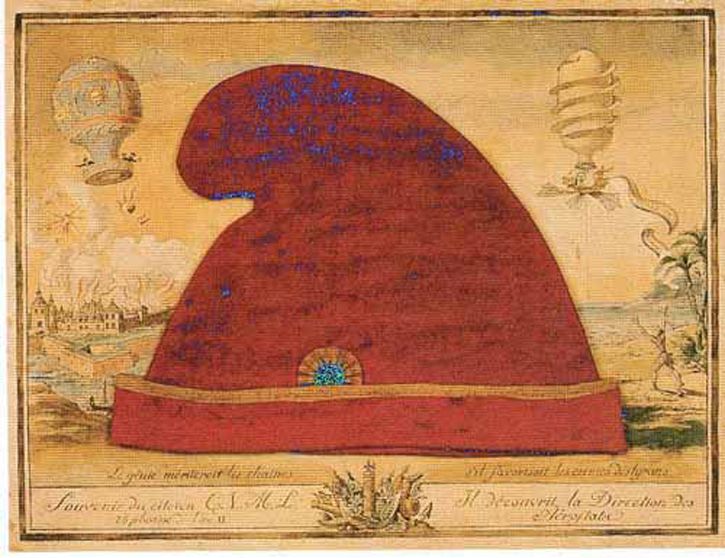
Image: Phrygian cap
-Google_images.jpg)
Image: Phrygian cap (French Revolution, 'Liberty Leading the People' (1830))

Image: Phrygian cap (First Spanish Republic, caricature of Tomas Padro Pedret)
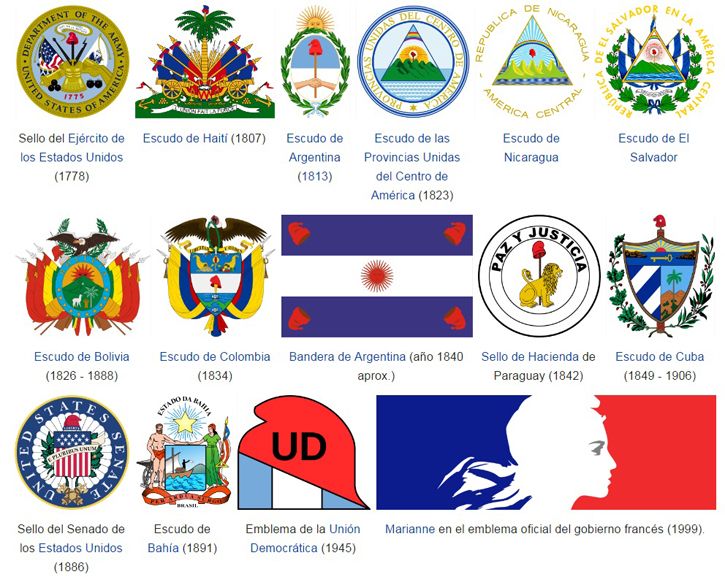
Images: Phrygian cap symbolism in American shields (American States)

Photo: Phrygian cap (Wise Men, Basilica of Sant'Apollinare Nuovo, Ravenna, Italy)
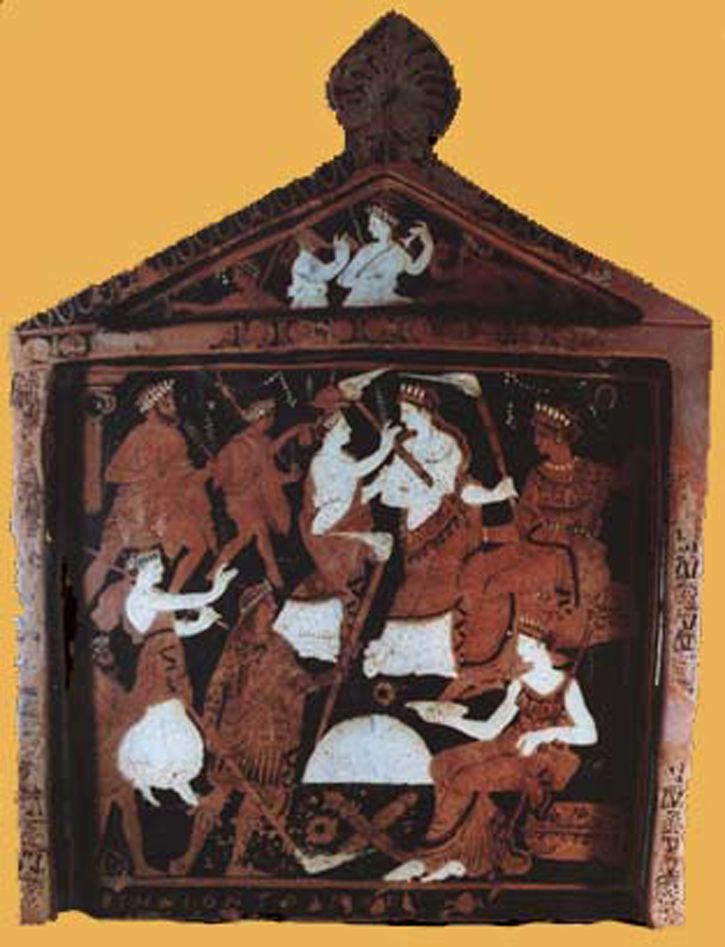
Image: Eleusinian Mysteries

Image: Pope's tiara (Innocence III)
Finally regarding the Phrygian god Attis, traces of his cult can also be found in Barcelona, since recently, in 2000, a relief of Attis, dated in the first half of the first century B.C., was found in the ancient wall of Barcino, and according to experts of the cult of Cibeles and Attis is present from the moment of the foundation of Barcino by emperor Augustus in the first century B.C. The museum code of the relief is MHCB-7844 and it can be found in the Museum of History of Barcelona, for those who want to investigate more about this archaeological piece. Also worth mentioning that the celebration of Cibeles and the resurrection of Attis were on March 25, the day of spring equinox.
Some traces of the cult of Attis were also found in Tarraco, now Tarragona, and even in Cordoba, southern Spain.

Image: Attis (1st century AD, Barcelona, Barcelona City History Museum, MHCB-7844)
On the other hand, today we can see a representation of the Virgin in the Church of Santa Maria del Mar, where she is represented with a boat at her feet – a clear symbol of the Virgin de las Arenas or the sea and of the sailors; but it is also important to mention that goddess Isis in Ancient Egypt was also represented with a boat, as well as the goddess Ishtar in the Assyrian tablets. The ceremony of worship in ancient Egypt was held on a hill, and the boat of Isis was carried by priests in a procession that ate buns marked with the sign of the cross Ankh. Note also the use of the symbolism of the barque of Peter in the Catholic Church, which is a symbol of the Church, and the naves of the churches have shape of an inverted ship's hull, and then appears as a kind of instrument for celestial navigation.

Photo: Virgin Mary in the Santa María del Mar church (inside) - Barcelona

Photo: Goddess Isis in the solar barque (Temple of Dendera, Egypt) (Source: Olaf Tausch)

Image: Inanna/Ishtar over a sacred barque (Sumeria/Babilonia/Asiria)
Vitruvius and its relation to the position of the Temples in Roman Barcelona
According to Vitruvius, the most important Roman architect, on whose works the Romans based when they built their cities, some temples such as dedicated to goddess Venus, should have been erected outside the city walls, and in this case following the guidelines of Vitruvius, probably (since there is no historical record) the temple to Venus should have been facing the sea and situated next to the walls of Barcino, i.e., where once the Roman church of Santa María de Las Arenas was located and where according to tradition the remains of Santa Eulalia have been found, and where some historians speak of a much older temple, dedicated in this case to the Astarte of the Phoenicians, who at some point in history is believed that reached the coast of Barcelona, and probably have located their temple to the goddess, where today the majestic Basilica of Santa Maria del Mar rises.

Image: Vitruvius
Let`s also mention that the foundation of Roman Barcelona in the first century B.C. as Colonia Iulia Augusta Faventia Paterna Barcino (COL IVL AVG FAV PAT BARCIN), the city later known as Barcino, by Emperor Augustus, was carried out following the parameters of the foundation of Roman cities of Vitruvius. Well, it was founded in the very few meters from the current Sant Jaume (Plaça de Sant Jaume), where the central axis of the Roman city were drawn according to an ancient ritual that is believed to be an Etruscan heritage. During this ritual a sort of 'gnomon' was placed in a hole in a chosen place, and it casted the shadows that marked the location of the sun at noon on certain dates and the East-West (called Decumanus), and North-South (called Cardus) axes of the new Roman city were drawn, varying in some particular cases the orientation of these axes depending on the terrain. Note that this city foundation system was practically the same in all cultures in the world since immemorial times, and was picked up by Vitruvius in his works. This central axis from which a Roman city was built had a profound esoteric meaning, as it symbolized the Axis-Mundi, or the point at which the three worlds (underground or world of the ancestors, the physical world where we live, and the celestial world of the deities) united into one. The site chosen for the foundation of Barcino soon became the main altar of the Temple of Augustus which was built there. The four remaining columns of it you can admire in the Catalonia Excursionist Centre. The Temple of Augustus was the political, economic and religious center of Roman Barcelona, and even today remains the administrative center of Barcelona and even Catalonia.
In the case of Barcelona, the center of this new 'mundus' was the top of a small hill called Mont Taber (also called ‘the Miracle hill’, which as some people believe comes from the word ‘Thabor’ that perhaps its inhabitants imposed in ancient times to commemorate the miracle of the Transfiguration of the Lord verified according to tradition in the mountain of the same name in the modern Israel, as we can read in book 'Barcelona Antigua y Moderna - Volume L', Don Andrés Avelino Pi y Arimon). Moreover, according to scholars of Sacred Science, the name of Monte Taber it is related to the word Tabernacle, because in the Bible, the sacred stone or the Ark of the Covenant is situated in the center of the Tabernacle.

Photo: Millstone in the place of the foundation of Barcelona
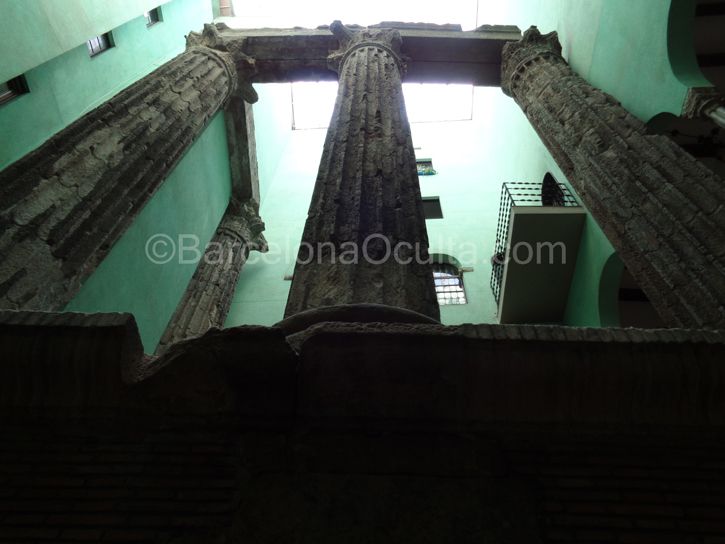
Photo: Roman columns (Barcelona)
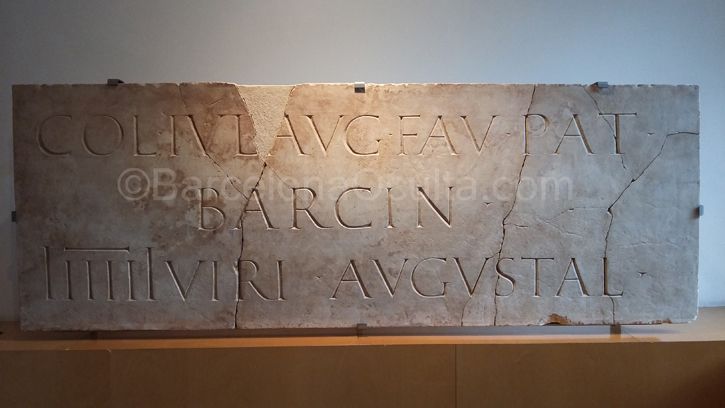
Photo: Roman marble plaque with the name of Barcino (Barcelona City History Museum)
It is important to note that generally the cultures that previously had inhabited the cities with a certain sacredness placed their centers and central axis of the proto-cities in the same place that the following cultures, in most cases, in these holy cities, there are hills or mountains. In the case of Rome and Paris there are 7 hills; in Barcelona we can speak of 7 hills or ‘turós’, and although the discussion about which exactly would these seven hills be does not cease yet, the 3 best known are ‘Turó de la Rovira’, ‘el Carmel’, and ‘Creueta del Coll’. Countless examples of that has been discovered within a few last, such as in South America, Santiago of Chile, which was founded on today’s Plaza Mayor (now Plaza de Armas) by the Spaniards, on the same central axis that the Inka empire previously established under identical rituals that collects Vitruvio from the Etruscan tradition. In the case of Barcelona it is not less than the fact that Laietan tribe prior to the arrival of the Romans has located its centers both in the same Mont Taber, as on Montjuic. We can then imagine that since prehistoric times other pre-Laietan tribes already had inhabited the same places and had chosen these sites in the same way subsequently, indicating some points with large menhirs which, as Mireia Valls tells us in the book 'La Barcelona Subterránea', were found in some places in Barcelona, and on Montjuic.
-rupestreweb.info.jpg)
Image: Pre-Inca Santiago of Chile (Possible system of Ceques, in Santiago (Bustamante and Moyano 2012) (Source: rupestreweb.info))
A hypothetical Vesica Pisces and some symbols in the city
As some already know, Vesica Pisces is the geometric figure formed by joining two circles of equal diameter in such way that they intersect at two points and leave their respective centers on perimeter the other. We can find interesting points about the urban plan of Barcelona where this figure is hypothetically present. If we take a current map of Barcelona, and connect with an imaginary line the Paral·lel and Meridiana avenues in Port Vell clock (or 'Torre del Rellotge' which in ancient times was the maritime lighthouse of Barcelona), as indicated in our Sign Alignments, and then draw a bisector from the vertex angle of 90 degrees that they form towards the North-West, we will see that this bisector follows the same path as the Cardus Maximus (vertical axis of the Roman city), and crosses the following important points of Barcelona: Plaza Sant Jaume, Plaza Catalunya, Paseo de Gracia, the Obelisk of Avenue Diagonal with Paseo de Gracia, reaching the magic mountain of Montserrat, several kilometers outside the city. If we narrow this line between the clock Puerto Viejo (Port Vell) and the Obelisk, we realize that taking the other following important points in the city, we will display a Vesica Pisces. The other points that would form the geometric construction are as follows: as intersection points of the circles to the right we have Peter`s Square (Plaça del Pedró) in Raval, and to the left from the Arc de Triomf in the top end we have the obelisk on Avenida Diagonal (former square Cinco de Oros), and at the lower end we will have the Clock Tower (Torre del Rellotge). A straight vertical line that follows the line of the two diamentres of the two circles cut them in the following places from botton to top: Saint James’s Square (Plaça de Sant Jaume), parish of Saint Anne (Parroquia de Santa Anna) and the cross of Paseo de Gracia with Gran Via Avenue. This way the Saint Anne parish is found exactly in the center of this Vesica Piscis.
We highlight these 7 points for being sufficiently important in the history of Barcelona:
Pedró's square (Plaça del Pedrò): square whose name originates from a landmark (or large stone) that marked the spot where Carmen street and Hospital street divided, which in ancient times were roads coming from the Llobregat river and the mountain of Montjuic. It is noteworthy that just this place is designated as the place where the co-patron saint of Barcelona martyr Santa Eulalia was crucified. And yet, it is believed that there was one of the menhirs, disappeared today, erected by the original inhabitants of the pre-Roman city. Also an old chapel in the Romanesque style called San Lazaro that still remains there. The monument on the square is the oldest of Barcelona. It is called the Fountain of Santa Eulalia, although it has undergone several restorations. At first the original sculpture was built in 1673 and represents, in a striking way, an obelisk with an image of Santa Eulalia on top.

Photo: Pedró's square (Plaça del Pedró) (Raval, Barcelona)
Triumphal Arch (Arc de Triomf): The Arc de Triomf is built as the main entrance of the Universal Exhibition of 1888. Sculptures of its friezes are of special interest, in them various allegories of deities as Cibeles, Palas-Athena, Hercules, Mercury and others appear. This arch connects the Paseo de San Juan, saint is the patron of Freemasonry, and Paseo de Lluis Companys, named in honor of a President of the Generalitat of Catalonia, and a proven member of Freemasonry.

Photo: Arc de Triomphe (Arc de Triomf) (Barcelona)
Clock Tower (Torre del Rellotge): It was the first Barcelona`s harbor lighthouse, built in 1772. And it is important because it was one of the locations used for measurement of the current unit of measurement known as meter (one hundred centimeters) by the French scientist Pierre François Méchain, imbued with the ideas of universality of the French Revolution.

Photo: Clock Tower (Torre del Rellotge) (Barcelona)
Saint James`s square (Plaça de Sant Jaume): The central point of the ancient Roman Barcelona, where the Temple of Augustus was situated and which is today the political center of Catalonia and Barcelona and the point of intersection between the straight line from the Clock Tower, and the one of the circles of the Vesica Pisces.

Photo: Saint James`s square (Plaça de Sant Jaume) (Barcelona)
Saint Anne parish (Parroquia de Santa Anna): It`s a small church dating from the twelfth century, at the time it was part of the Monastery of Santa Ana of the Augustinians. Currently it belongs to the Order of Knights of the Holy Sepulcher of Jerusalem, one of the oldest orders of chivalry, even more ancient that Order of the Templars. A legend tells that it was built on a site of an ancient Celtic temple dedicated to the goddess reminiscent Danann (Dana, Ana), whose Irish Celts worshipers were known as Tuatha De Danann.

Photo: Saint Anne parish (Parroquia de Santa Anna) (Barcelona)
Gran Via with Paseo de Gracia: It is one of the most important crossroads of the city, as the Gran Via de les Corts Catalanes is the main horizontal axis of the city of Barcelona, and Paseo de Gracia is the main shopping street. At this junction there is a monumental fountain, built in 1952.

Photo: Gran Via with Paseo de Gracia (Barcelona)
Obelisk of Avinguda Diagonal: Opened in presence of Lluis Companys in 1936 as a tribute to Francesc Pi i Maragall, who was a President of the Spanish Republic, and a member of Freemasonry. For various political and historical vicissitudes, it has undergone several renovations, some statues were put and taken out, but keeping the original obelisk. Also we mentioned that initially it was in the center of the square Cinco de Oros. Currently it is on another major highway that crosses Barcelona, Diagonal Avenue and Paseo de Gracia.

Photo: Obelisk of Avinguda Diagonal (Barcelona)
Finally, near the center of this Vesica Pisces that can be drawn with these points, its center corresponds to the parish of Saint Anne and the Plaça de Catalunya, that if we look from above, has shape of an owl, one of the most significant symbols of some secret societies, likewise, can find other symbols on the square, such as a pentagon, or a circle with 8 rays similar to the one of the wind rose. The number 8 has a significant presence in Barcelona (especially in what refers to the construction of the Order of the Temple), as we shall see when we make mention of the octagonal layout of the urban plan by Ildefons Cerda.

Photo: Plaça de Catalunya (Barcelona)
The fortifications of French origin and the Ciudadela Park
Speaking about the construction of fortifications in Barcelona, we name a famous French military engineer Sébastien Le Prestre of Vauban and mention the influence of rationalist ideas that Freemasonry had spread in France. Already at the time, scholars such as Leonardo da Vinci, Michelangelo or Albrecht Dürer had studied the design of good protective construction. Many military engineers, experts in the construction of fortifications that can now be found in several cities in Europe, fell under those Masonic influences. Likewise, the designers and builders of the fortification that existed where now there is the Citadel Park (Parque de la Ciudadela), Barcelona, came under that influence.
As it is described in the novel 'Vae Victus' by Albert Sánchez Piñol, Marquis de Vauban was one of the precedents of the elitist spiritual Freemasonry and they called him "the great architect". The author notes that masons generally follow the ideas of the world and the rationality of the cosmos. No wonder Frederic-Auguste Bartholdi, a recognized famous sculptor, member of Freemasonry whose key work became the Statue of Liberty in New York, also put up a monument to the Marquis engineer Marshal Vauban in the city of Avallon (France).
Robert Ambelain in his book 'The Secret Masonic' brings up an interesting question about it: "... is it thought perhaps that Mr. Sebastien Le Prestre, Lord of Vauban, administrative officer of fortifications in 1678, and Marshal of France in 1703, the man who covered France of several works, military, urban or port ones, did not resort to corporations of masons and carpenters? ... ". Knowledge of how to build quickly and safely a place of protection, a covered France fortress, a trench, a fortification, was of a priority interest.
Inspired by the vaubianas ideas, Marquis of Verboom builds fortification 'Ciutadella' of Barcelona in 1715, for Philip V to defend the military citadel of a possible uprising, due to surrender at the end of the War of Spanish Succession. Verboom had a professional relationship with Vauban. As the author Josep Maria Montaner in 'La modernització de l'Mental utillatge de l'architecture Catalunya (Catalan Studies Institute, 1990)', the layout of the Citadel fully reflects the Vauban`s model that he widespread in France in the late XVII century: use of regular polygonal shapes, defining a double wall, placing bastions in a star as well as the provision of fully rational and orthogonal interior, so that is dominated by a large central square in the center.
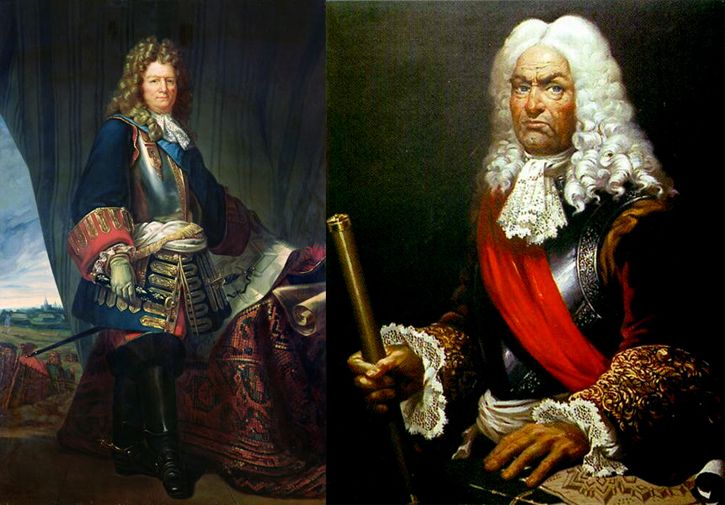
Images: Sebastien le Prestre de Vauban, and Prospero Verboom

Image: The Fortification in the ancient citadel (Barcelona)

Image: Flaming Star
It is worth mentioning as if coincidence was involved, that the pentagonal shape was used as a prototype for building these fortresses, since it would be one of the best shapes for a fortress that protects a citadel. As says Aldo Lavagnini in 'Companion Manual': "... the strength of the whole of this geometric figure also made to choose this figure more than once by the architects of fortifications, because its obtuse angles provide more resistance than those of a square building" .
It is curious because the pentagon has 5 sides, and the number 5 also has an esoteric significance, besides representing goddess Venus we were talking about earlier. It is quite striking to note that where the fortress of the Citadel was before, now there is a park with a beautiful, large waterfall, commissioned by Fontserè brothers in Barcelona, both masons, and that among many curiosities of the site, its construction and details, has a major sculptural group that represents precisely the birth of Venus.
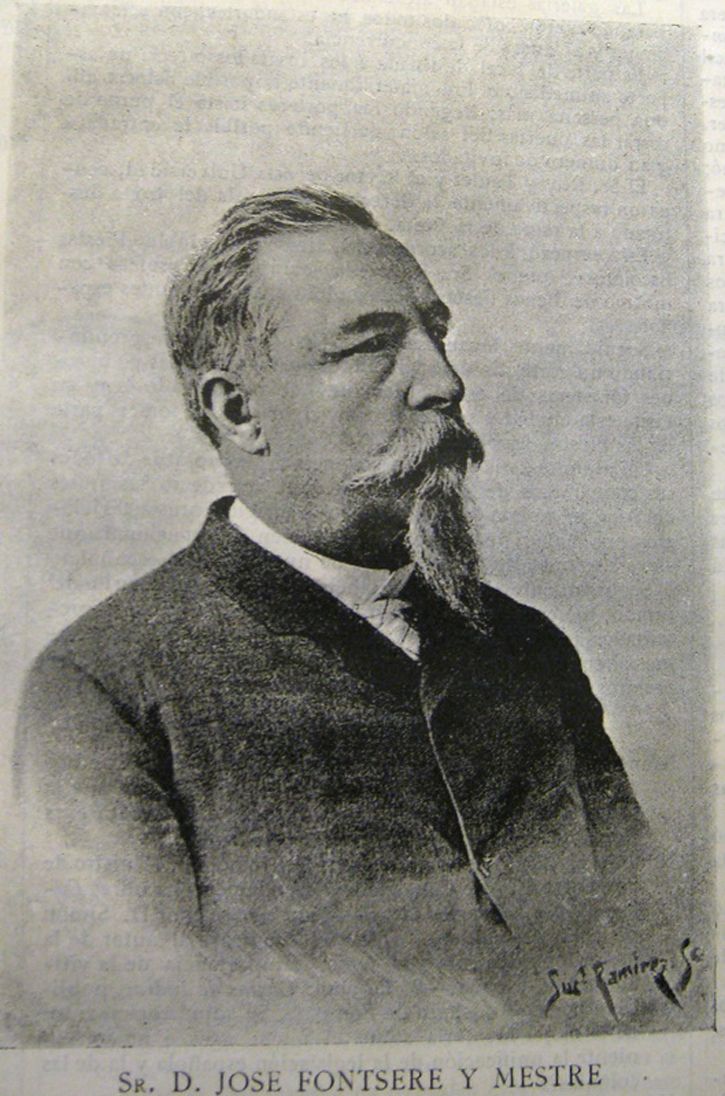
Image: Josep Fontserè i Mestre

Image: The birth of Venus by Botticelli (Uffizi Gallery, Florence, Italy)

Photo: Citadel park waterfall (Barcelona)
The mysterious development of modern urban layout of Barcelona
There are three dates that marked important modern changes in the city. The first was 1888, when the city would host the world`s fair (universal exposition), for which major changes throughout the area that now comprises what is the Park of Citadel (Parque de la Ciudadela) were carried out, where the demolition of all military fortification that was there, except for a few buildings that still remain, had already begun since 1867 for the purpose of the creation of a large park with innumerable secret symbols that still can be found today, such as the ones that we mentioned in the previous text. Moreover, the third defensive wall Barcelona was demolished and the city opened for what is known as the Eixample (expansion, widening), planned by Ildefons Cerdá.
Since the foundation of Barcelona by the Romans the octagon is a recurring figure. The first Roman wall has an octagonal shape. Subsequently, with the great influence of the Knights Templar (Templars), several churches with octagonal turrets and bell towers were built in Barcelona. Also when Ildefons Cerda presented his draft of the Eixample, each block of the grid had an octagonal shape, so that today we can see the characteristic 'bevels' in every corner of the streets of the Eixample of Barcelona.
Based on a study carried out by academic Gabriela Benitez, Faculty of Architecture of the University of the State of Morelos, Cuernavaca (Mexico), and with the express permission of her, on this website we will mention that there are curious parallels in the urban development between Washington in the United States and Barcelona, as in both cases engineers and planners imbued with the same ideas born in France were involved, from the hand of such an important secret society as Freemasonry.
As the key figure in Barcelona was Ildefons Cerda (1859), in Washington (United States) it was a French architect and military engineer Pierre Charles L'Enfant (1791), who was responsible for its design. Both characters are linked through concepts established by Freemasonry in the nineteenth century.
A geometrical resemblance to the axes is observed and a regular figure of a 5-sided polygon can be seen in both designs. A longitudinal axis intersected by diagonals projected with a special sentence, indicating knowledge of the number of the golden ratio (1.618). Besides the above mentioned, secondary deviations in the direction of avenues appear, indicating the presence of regular polygons or the figure of an equilateral triangle. The above mentioned geometric elements used in a particular historical and social context point out the influence of concepts of Freemasonry, in turn influenced by the Industrial Revolution (1758), and the subsequent French Revolution (1789), at that time.
With a due respect, in a certain sense, to the old layout of both cities (also based on concepts of certain religious beliefs), and making use of the same elements of geometry and mathematics, the new urban planning was designed. Some elements of both cities include certain social and symbolic criteria, linked to the personality and character of the architect and some Masonic principles. There aren`t any proofs to date that Ildefons Cerda was a freemason, although his daughter Clotilde confirmed that, being herself a member of Freemasonry; but both her knowledge and literature about the design of the Eixample in Barcelona admit that possibility.
There is a lot of information about design of Washington on the Internet, but the purpose of this website is to delve into the history of Barcelona. In the design of Barcelona of military engineer Ildefons Cerdá also appear diagonals, central axes based on the ones of the ancient city, boundaries and borders marked by squares and parameters slightly offset respectively to its axis lines. In an aerial view you can conclude the emergence of equilateral triangles in the ancient city and the dominance of the hexagon, and a heptagon linked by an axis also appears. All this wrapped in an orthogonal grid rotated in the direction of the principal axis of polygons. To detect specific centers linking avenues and axes, the scheme of Barcelona`s layout should be applied over squares or blocks together, and this way referential landmarks, boundaries and borders can be defined. As well as in Washington, in Barcelona a polygon of 7 sides and an octagon are also primary detected. These polygons are subject to a specific axis, which in Barcelona is oriented northeast-southwest (NE-SW), approximately.
In Barcelona the hexagonal and triangular figures related to the area of the medieval city show up.
In both cities it is possible to apply the symbolic definitions of Freemasonry, as well as geometric figures themselves, the physical content that boast some of them admit that probability (e.g. Obelisk Paseo de Gracia, towers Arts-Mapfre, Sagrada Familia, etc ...).
From the roman castrum through the medieval town, the Citadel, the military establishment of Barceloneta, and to the widening of Cerdá, the entwinements are preserved without any evident deterioration and stay perfectly recognizable, and each party holds a certain historical specialization.
The second important date was 1929, when Barcelona hosted the International Exhibition and the urban expansion continued in another important part of the city - Spain Square (Plaça Espanya) and Montjuic. As the third and final date of the important ones, that scored so far a big change in the urbanism of Barcelona, was 1992, when the city hosted the Olympics and the Olympic Port is built, with its two Arts and Mapfre towers that symbolize the pillars of Hercules, or the two pillars of Masonry, and where we also can find sculptures of a cube, a pyramid and a sphere.
As an epilogue, commenting that through the ages, and in some mysterious way, Nature causes Barcelona to develop by the hand of an invisible force (perhaps a collective unconscious connected to our minds), and some societies secret co-operate in urban development and construction of monuments, temples, buildings, following a specific order, a certain plan that corresponds mostly to holy cities.
Sources:
Benítez Fuentes, Gabriela, “Alterar y trastocar el Espacio” en Revista Inventio, la génesis de la cultura universitaria en Morelos, N° 5, 2007, Pp. 99-107, Universidad autónomo del Estado de Morelos, Cuernavaca.
Universidad Nacional de Ingeniería (UNI, Perú), Facultad de Arquitectura, Urbanismo y Artes - ‘Práctica Nº 4’ (UNI-FAUA)
La Ilustración española y americana. Año XXII. Núm. 15. Madrid, 22 de abril de 1878
Andrés Avelino Pi y Arimon – ‘Barcelona Antigua y Moderna - Tomo L’
Rubén Stehberg, Gonzalo Sotomayor (Boletín del Museo Nacional de Historia Natural, Chile 61: 85-149 (2012)) – ‘Mapocho Incaico’
Mireia Valls – ‘La Barcelona Subterránea’
Josep Maria Montaner - ‘La modernització de l'utillatge mental de l'arquitectura a Catalunya (Institut d'Estudis Catalans, 1990)’
Aldo Lavagnini - ‘Manuel del Compañero’
Robert Amelain – ‘El Secreto Masónico’
Alberto Sánchez Piñol - ‘Vae Victus’
 BARCELONA Tours in English, Spanish, Russian, French, Portuguese, German & Italian. Recommended by tripadvisor
BARCELONA Tours in English, Spanish, Russian, French, Portuguese, German & Italian. Recommended by tripadvisor











, dibujo de Antoniadi, 1939.jpg)


.jpg)






-Google_images.jpg)













-rupestreweb.info.jpg)













